FYBUSH.COM/SITE OF THE WEEK
NEEDS YOUR SUPPORT! (AND YOU CAN GET A FREE TOWER SITE CALENDAR
IF YOU PLEDGE NOW...) CLICK HERE TO
LEARN MORE...
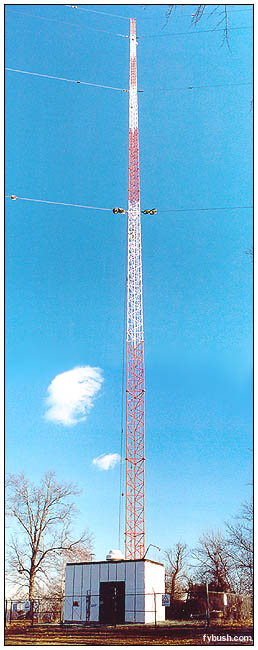 April 24 - May 1, 2003 April 24 - May 1, 2003
High Island, New York
There are, as far as this tower hunter knows, only two places
in North America where a single tower radiates not one but two
non-directional 50,000 watt signals.
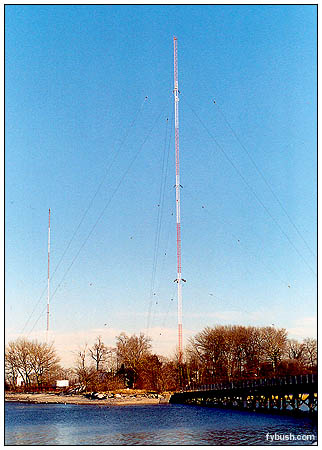 One
of those spots is Hornby, Ontario, home to CHWO (740) and CJBC
(860) and their shared tower. One
of those spots is Hornby, Ontario, home to CHWO (740) and CJBC
(860) and their shared tower.
The other is a little spot of land that sits just off City
Island, itself a narrow spit of an island hanging out into Long
Island Sound from the Bronx.
For more than four decades, this island, known as High Island,
has been home to two of the biggest New York City AM signals:
WFAN (formerly WNBC) on 660 and WCBS on 880.
A few months ago, we were privileged to get a look at this
magnificent site...and we're thrilled to be able to share it
with all of you.
It wouldn't be Site of the Week without a little history lesson,
though - so here goes:
New York's NBC and CBS flagships have a peripatetic story.
The signal we now know as WFAN began its life in 1922 as WEAF,
operating from the AT&T building at 463 West Street in lower
Manhattan. (It replaced an earlier entry called WBAY, which transmitted
from an AT&T building on Walker Street - the metal frame
of which resonated at 360 meters, absorbing most of the WBAY
signal before it could get out to the world!)
WEAF boasted the first commercial broadcast in August 1922
(though there's been ample evidence since then that other stations
in fact beat WEAF to the punch on that account) and the honor
of becoming NBC's Red Network flagship in 1926. In October 1927,
WEAF (then on 610 kHz, thiough it would move to 660 a year later)
went to 50,000 watts from a site in Bellmore, Long Island - but
that site would last just over 13 years, replaced in 1940 by
a superior location on Long Island's north shore, at a spot called
Sands Point in Port Washington.
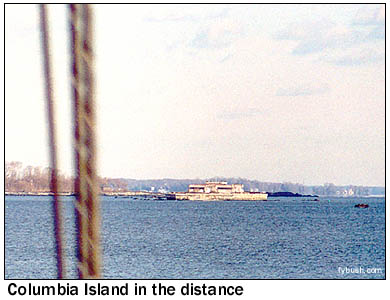 The
CBS flagship had an even rockier route to travel before it arrived
at High Island. Originally known as WAHG, for radio entrepreneur
A.H. Grebe, who put the signal on the air in 1924, the station
became WABC (for "Atlantic Broadcasting Company" -
the network later known as ABC wouldn't even begin operation
- as NBC Blue - for another year) in 1926 and moved around the
dial before landing on 860 kHz with 5,000 watts in 1928. That
was also the year that CBS bought the station; in 1931 it boosted
power to 50,000 watts and moved from Cross Bay Boulevard in Queens
(where it had been for only a few years, having moved from the
roof of the Grebe facility in Richmond Hill, Queens) to a site
in Wayne, New Jersey. Radio historian Al Germond reports, tantalizingly,
that the Wayne site marked the very first installation of a Blaw-Knox
diamond-shaped vertical radiator, identical to those that would
be built a year later at WSM
in Nashville and WLW
in Cincinnati. The Wayne site, too, would prove temporary:
by the time World War II began, WABC (which moved to 880 as part
of the NARBA shifts of March 1941 and changed calls to WCBS in
December 1946, around the same time that WEAF became WNBC) had
an unusual new home. The
CBS flagship had an even rockier route to travel before it arrived
at High Island. Originally known as WAHG, for radio entrepreneur
A.H. Grebe, who put the signal on the air in 1924, the station
became WABC (for "Atlantic Broadcasting Company" -
the network later known as ABC wouldn't even begin operation
- as NBC Blue - for another year) in 1926 and moved around the
dial before landing on 860 kHz with 5,000 watts in 1928. That
was also the year that CBS bought the station; in 1931 it boosted
power to 50,000 watts and moved from Cross Bay Boulevard in Queens
(where it had been for only a few years, having moved from the
roof of the Grebe facility in Richmond Hill, Queens) to a site
in Wayne, New Jersey. Radio historian Al Germond reports, tantalizingly,
that the Wayne site marked the very first installation of a Blaw-Knox
diamond-shaped vertical radiator, identical to those that would
be built a year later at WSM
in Nashville and WLW
in Cincinnati. The Wayne site, too, would prove temporary:
by the time World War II began, WABC (which moved to 880 as part
of the NARBA shifts of March 1941 and changed calls to WCBS in
December 1946, around the same time that WEAF became WNBC) had
an unusual new home.
Columbia Island was a man-made island in Long Island Sound,
just off the shore near the Bronx-Westchester line, reachable
only by boat. There, CBS built a mammoth tower, some 20 feet
to a side and topped by an even bigger capacitance hat. (Its
height was limited by approach paths to LaGuardia Airport on
the other side of the sound.) With the ground system running
right into the waters of the sound, it gave WCBS a massive signal
up the coast into New England.
And then, in the early sixties, CBS began looking for a new
home for its 880 signal. (Why did it need to leave Columbia Island?
That's a question I haven't yet been able to answer; the island
has apparently been vacant ever since, and the tower is long
gone. I don't even know who owns the island now, or what might
be left inside that tantalizing building seen in the distance
from High Island...)
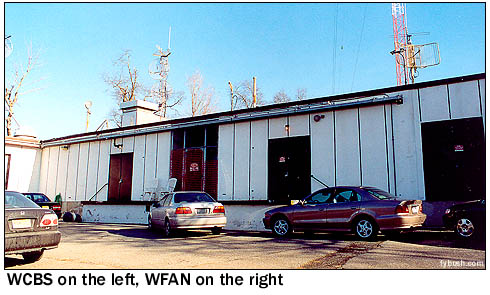 In
any event, the timing was fortuitous: NBC, too, needed to find
a new home for the WNBC signal - and for that you can apparently
blame Perry Como. In
any event, the timing was fortuitous: NBC, too, needed to find
a new home for the WNBC signal - and for that you can apparently
blame Perry Como.
The crooner, an NBC staple, was nearing the end of his contract
and negotiating for its renewal (or so the story goes.) At the
same time, he was looking for a new home. And somehow, legend
has it, he realized that NBC owned a beautiful piece of land
in a desirable neighborhood on the North Shore of Long Island...and
made the title to the Sands Point property part of his renewal
deal.
So WNBC was sent packing again, and soon realized that it
made sense to build a joint facility with rival WCBS, which was
already beginning to design a new site at High Island.
High Island had been a summer resort, with small cabins available
for rental; adjacent City Island was and is a little fishing
village with some excellent seafood restaurants and a tightly-knit
residential community accessible only through Pelham Bay Park.
To visit City Island today, you'd never know that you were within
New York city limits - but if you're reading this page, you'd
be craning your neck to see that tower that's behind the gate
at 700 King Street. So without further ado, let's open that gate,
proceed (carefully!) over the one-lane metal bridge, and pull
into the driveway of this most interesting site...
(OK, one more bit of history first: look to your right once
you're on the island and you can see a log cabin, the last remnant
of the "old" High Island. The island's caretaker lives
there. Now, towers:)
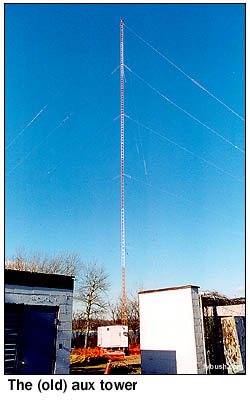 Construction
on High Island was completed in the summer of 1963, and both
stations were moved in by the fall, just in time to broadcast
news of the Kennedy assassination. Dresser built the 529-foot
tower, which was of a most unusual design: because it had to
accommodate signals on both 660 and 880 kHz, it was built as
a segmented (Franklin-type) antenna, with insulators separating
a section about 100 feet below the top of the tower from the
rest of the tower. A tuning network was installed within that
insulated section, more than 400 feet above the ground; the 880
signal fed just the lower portion of the tower, while the 660
signal, with its longer wavelength, used the entire tower. It
was a good idea at the time... Construction
on High Island was completed in the summer of 1963, and both
stations were moved in by the fall, just in time to broadcast
news of the Kennedy assassination. Dresser built the 529-foot
tower, which was of a most unusual design: because it had to
accommodate signals on both 660 and 880 kHz, it was built as
a segmented (Franklin-type) antenna, with insulators separating
a section about 100 feet below the top of the tower from the
rest of the tower. A tuning network was installed within that
insulated section, more than 400 feet above the ground; the 880
signal fed just the lower portion of the tower, while the 660
signal, with its longer wavelength, used the entire tower. It
was a good idea at the time...
The transmitter building was also unusual in design. While
WNBC and WCBS were cooperating in sharing this facility, they
were still competitors, and the physical design of the plant
reflected that. WCBS occupied the east wing of the structure,
separated by a sort of breezeway from WNBC's west wing. (In the
photo at the top of the page, WCBS is on the left, the gate to
the breezeway is in the middle and WFAN is on the right.)
Befitting its NBC ownership and RCA parentage, the WNBC facility
was RCA from stem to stern, including the infamous "Amplifuzz"
- er, Ampliphase - 50 kW transmitter, the memory of which still
brings some grown engineers of my acquaintance to their knees.
I'm not sure what WCBS used in its initial plant design.
Even today, nearly a decade after WCBS owner Infinity bought
WFAN from Emmis and brought the stations - and the island - under
a single owner, one has to go outside to get from the 880 transmitter
rooms to the 660 side.
Across the parking lot from the building sit backup generators
for both stations (the power supply to the island is a constant
source of irritation, apparently) and an auxiliary tower. In
its current form, that aux tower can't handle 50 kW from both
stations at once, and the Harris DX50 transmitters both stations
use don't like the load the short tower presents. That will soon
change; the pieces of a new tower were already on site when we
visited in January 2003, and it will soon replace this old tower.
But this won't be the first new tower on High Island. The
original main tower there lasted just four short years, and its
demise was a miracle of bad timing.
At 4:21 on Sunday afternoon, August 27, 1967, a small plane
hit the tower, sending it crashing to the ground with such force
that pieces of it became embedded in some of the rocks on the
island, where they can be seen (above) to this very day. The
plane's pilot was killed, and WNBC and WCBS were knocked off
the air - just hours before WCBS was to have dropped its full-service
format to go all news, challenging Westinghouse's two-year-old
WINS (1010) format.
On Monday morning, the news format debuted instead on WCBS-FM
(101.1), which had itself been readying a new "Young Sound"
format. WNBC found a temporary home back in New Jersey, diplexing
into the Lodi tower of rival WABC (770), whose audio could be
heard not so faintly behind WNBC's on 660 for a time. WCBS was
offered the use of a backup transmitter at WOR in Carlstadt,
N.J., but instead accepted an offer from WLIB (1190) to use the
site along the East River in Astoria, Queens that it had just
abandoned in favor of a site in Lyndhurst, N.J. Within a few
weeks, WCBS and WNBC were back on the air from High Island with
a temporary tower; it would be the end of the year before both
were back to 50 kilowatts from the current tower.
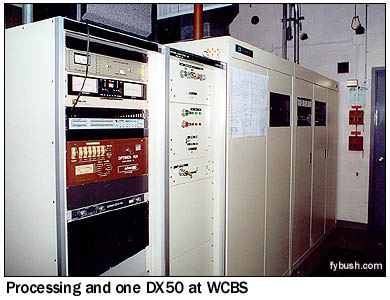 Let's
go inside the WCBS side of the building and see what's there
now, shall we? Entering the building, you'll see a Harris DX10
immediately to your right. This auxiliary transmitter came to
this site from New Jersey, where it was used by WINS in the mid-nineties
when that station (at the time still a full-fledged competitor
to WCBS) was rebuilding its site in Lyndhurst and was using the
auxiliary tower of WABC in Lodi. Let's
go inside the WCBS side of the building and see what's there
now, shall we? Entering the building, you'll see a Harris DX10
immediately to your right. This auxiliary transmitter came to
this site from New Jersey, where it was used by WINS in the mid-nineties
when that station (at the time still a full-fledged competitor
to WCBS) was rebuilding its site in Lyndhurst and was using the
auxiliary tower of WABC in Lodi.
Facing you is WCBS' primary transmitter, a Harris DX50, with
a rack of processing and monitoring gear just to the left of
it. Walk back to the next room, adjacent to a small engineering
office, and you'll see the older Continental 317 that preceded
the DX50, a twin in layout to the one we saw at sister station
KNX in Los
Angeles a few years back.
And yes, those are phasing units sitting next to the DX50
- on an non-directional station!
A few years back, WCBS and WFAN rebuilt the tower to eliminate
that insulated section in the middle. It proved to be a challenging
task to keep the unusual tower design tuned up properly, especially
when engineers needed to climb the tower to tweak the tuning
network way up there, and so that section was bridged and the
whole thing reconfigured as a conventional base-fed tower. (The
uppermost guy wires also function as top loading for the tower,
by the way.)
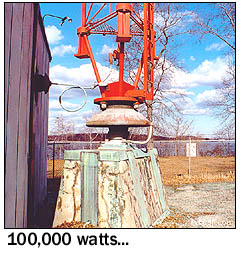 There's
an elaborate diplexing network in the doghouse building at the
tower base, but in addition to that, the phasing units are used
to better match the transmitters to the impedance of the transmission
lines out to the tower. You don't see that very often at non-DA
sites; in fact, I've never seen it in use anywhere
else. (I told you this was an unusual site!) There's
an elaborate diplexing network in the doghouse building at the
tower base, but in addition to that, the phasing units are used
to better match the transmitters to the impedance of the transmission
lines out to the tower. You don't see that very often at non-DA
sites; in fact, I've never seen it in use anywhere
else. (I told you this was an unusual site!)
Those little "feet" at the base of the vertical
tower segments are used to jack up the tower when the insulator
needs replacing; you can also see the copper straps that lead
to the ground system, which leads in turn right into Long Island
Sound.
The High Island signals are by far the best New York City
AMs along the Sound and out to New England; it's easy (and awfully
impressive) to sit on the beach in Westerly, R.I. or even the
southern shore of Cape Cod and tune into 660 at high noon as
though you were in the Bronx. The tradeoff comes in Manhattan;
the solid granite on which the island is built still blocks the
signals from reaching the West Side as well as you'd expect them
to. That's why the other New York AMs (with the perplexing exception
of WQEW on 1560, which uses an old site in Maspeth, Queens) blast
across the Hudson from the New Jersey Meadowlands.
Moving over to the 660 side, we enter to find ourselves in
a somewhat smaller transmitter room. There's a Gates 5 kW transmitter
here that still sees occasional aux use, as well as two 50 kilowatt
units: a Continental 317 that was one of the WNBC main transmitters
at the end and still functions as an aux, and down at the end
a Harris DX50 that serves as the primary transmitter for Don
Imus, Mike and the Mad Dog and the Mets. (Here, too, there are
phasing units; my back was to them while taking the 317 picture
above.)
Behind the Harris sits a room with power-handling equipment;
in the days of the Ampliphase, the big transformers sat back
here, but today's transmitters occupy a much smaller footprint.
And there's no bedroom in either side of the facility - by the
time it was built in 1963, these sites could and did operate
unattended. (Engineers from both stations are out here several
days a week doing maintenance, though.)
And that's our look at this site - but we weren't there by
ourselves! Accompanying us that fine January day were Boston
Radio Archives co-editor Garrett Wollman, whose
pictures can be seen here, and tower photographer extraordinaire
Jim Hawkins, who
has a nice page about our visit on his site. Go. Visit. Enjoy.
(But come back next week, won't you?)
Big thanks for making this week's visit possible
go to WFAN engineer and radio historian Mike Erickson, whose
own pages on Long Island radio history are well worth a visit;
Mark Olkowski, engineering manager of WCBS/WFAN/WINS/WNEW; Dick
James, WFAN engineering maintenance supervisor; and Dan Lohse,
WCBS engineering supervisor.
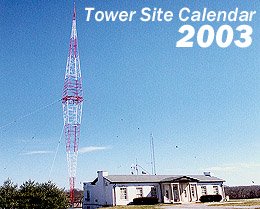 Want to see more neat sticks all year
round? Nashville's WSM (at right) is one of the more than
a dozen Tower Site images featured in the 2003 Tower Site Calendar,
still available from Tower Site of the Week and fybush.com. Want to see more neat sticks all year
round? Nashville's WSM (at right) is one of the more than
a dozen Tower Site images featured in the 2003 Tower Site Calendar,
still available from Tower Site of the Week and fybush.com.
If you liked last year's edition, you'll love this one: higher-quality
images (in addition to WSM, this year's edition includes Providence's
WHJJ; Mount Mansfield, Vermont; Buffalo's WBEN; KOMA in Oklahoma
City; WTIC, Hartford; Brookmans Park, England; WPAT, Paterson;
Four Times Square, New York; WIBC in Indianapolis; WWVA in Wheeling,
W.V.; WGN Chicago and more), more dates in radio history, a convenient
hole for hanging - and we'll even make sure all the dates fall
on the right days!
This year's edition is still available in limited quantities!
And this year, you can order with your Visa, MasterCard,
Discover or American Express by using the handy link below!
Better yet, here's an incentive to make your 2003 NERW/Site
of the Week subscription pledge a little early: support NERW/fybush.com
at the $60 level or higher, and you'll get this lovely calendar
for free! How can you go wrong? (Click here
to visit our Support page, where you can make your NERW contribution
with a major credit card...)
You can also order by mail; just send a check for $16
per calendar (NYS residents add 8% sales tax), shipping included,
to Scott Fybush, 92 Bonnie Brae Ave., Rochester
NY 14618.
Thanks for your support!
|